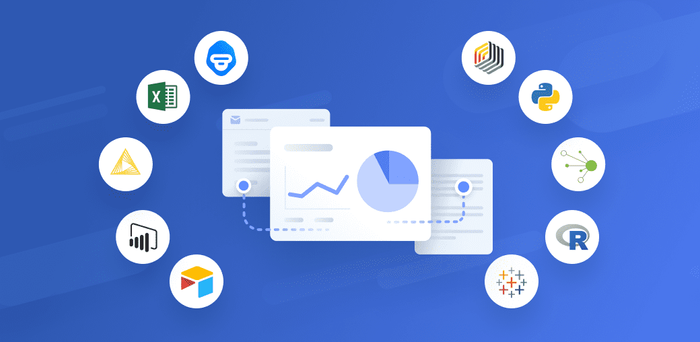As has been the case for the past few years, data democratization trends in 2021 will center on linking users to data and information in intuitive, accessible ways.
Enterprises and other organizations use intuitive tools and interfaces that help them achieve data democratization goals. These tools often include code snippets and plugins, machine learning AI models and open source data and code.
Our list of five noteworthy trends in data democratization showcases some of the ways organizations are embracing data democratization both among employees and in many customer-facing ways.
Safely connecting people with data directly can afford organizations with a more streamlined strategy from several angles. In particular, data democratization is one way organizations can derive more value from the data they already own.
Data Democratization Today
The primary goal of data democratization is to connect non-specialists with data on their own. The term “citizen access” is often used within discussions about data democratization, a nod to this overarching goal of removing or lessening barriers to access to the point where the vast majority of an enterprise workforce can gather and analyze data autonomously.
Why the push toward making data more accessible? For starters, many studies conducted over the past several years have consistently shown that data-focused organizations:
- Make better strategic decisions
- Achieve higher efficiency
- Benefit from improved customer satisfaction
- Generate larger profits
Forrester predicts that data-centric organizations will make $1.8 trillion annually by the end of 2021. According to the Experian 2020 Data Democratization Report, 81% of surveyed business leaders said data democratization is a key initiative.
5 Trends In Data Democratization
1. Self-Service Data Analytics Will Continue Driving Organizational Strategy
Modern data analytics platforms increasingly offer self-service data analytics that require low (or no) coding knowledge. Easy-to-understand dashboard interfaces allow non-experts to access and create data visualizations based on any number of parameters.
These features have become important not only because the core focus can help to streamline workflows, but also because of the enduring tech worker shortage. Data analysts and engineers are among the most sought-after professional roles across virtually every employment sector. Being able to bypass these experts for certain tasks like data visualization helps organizations use their tech workers in a more impactful way.
2. Medical Records As Individually Owned Assets Will Disrupt The Health Care Industry
New Health and Human Services regulations place the ownership of medical records directly into the hands of patients. Currently, medical data exists across disparate health care systems and most patients do not have a way to view their own health data in a holistic way. Instead, health data is often stored in fragments. A cardiologist may hold records related only to a patient’s heart health, while information about their diabetes treatments can only be accessed through their endocrinologist’s digital portal.
Records can be shared, but this is often a labor-intensive process for patients and medical staff, one that is prone to errors and oversight. Paving the way for centralized, individually owned health records remove barriers to access like needing to sign up for multiple online accounts. It also empowers patients by giving them more control over when their records are shared.
One way industry watchers expect this to play out is through smart apps that allow providers to scan a code to gain access about medications and other health indicators. For example, a pharmacist could quickly scan patient devices to check for drug interactions when a new prescription has been ordered.
Google’s Project Nightingale initiative, which uses machine learning data and AI to make patient care suggestions based on individual health records stored away from the platform. Health care startups are sure to apply predictive analytics in a similar way, fueling a totally new health care approach, one fueled by opt-in medical data sharing.
3. The Regulation Of Employee Analytics Will Change Employer Roles
Similar to the coming regulations related to medical data ownership, employee data is likely to become an individually-owned asset, as well. Industry watchers expect to see legislation introduced that targets AI bias, putting the responsibility on employers to ensure that the algorithms they use are consistent with real-world ethics. Basically, AI has an inherent bias based on the data it is provided, so employers will need to take pains to introduce data that is as unbiased as possible.
Employee analytics are used by organizations to inform decisions about a number of key workplace issues:
- Pay increases
- Performance bonuses
- Hiring decisions
- Promotions
- Application processing
Ideally, legislation around employee data will help to level the playing field for historically marginalized populations. When employees leave their positions at organizations, they will be able to take their data footprint home with them.
4. Unified Analytics Automation Platforms Will Become Widespread
Software that helps to promote data democratization typically includes automated unified analytics features. This software allows users to use drag-and-drop to create automations related to searching, storing and analyzing data. From there, it’s often just a few more clicks to create compelling data visualizations.
Unified analytics automation platforms will play a key role going forward because it will engage an increasing number of non-technical employees. Data analysts and engineers are valuable company assets that can better spend their time on deeper work versus data discovery and repetitive analytics tasks.
5. Customer-Facing Roles Will Benefit From Increased Data Democratization
Customer-facing departments like sales and customer service can deliver a more seamless experience with greater access to decision-making data and insights like past customer behavior. When enterprise workflows include multiple barriers between customer care personnel and customer data, response times and customer satisfaction suffer.
Organizations that are set up in a way that allows customer-facing associates to safely access key data can offer a more holistic, positive guest experience while improving efficiency and reducing overall costs.
Data democratization can enhance organizational processes in myriad ways. Still, it’s important to undertake data democratization steps with great care. Data must be protected at every point, from collection to handling to analytics.













